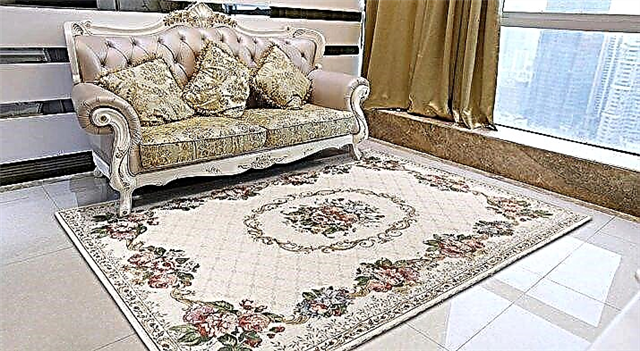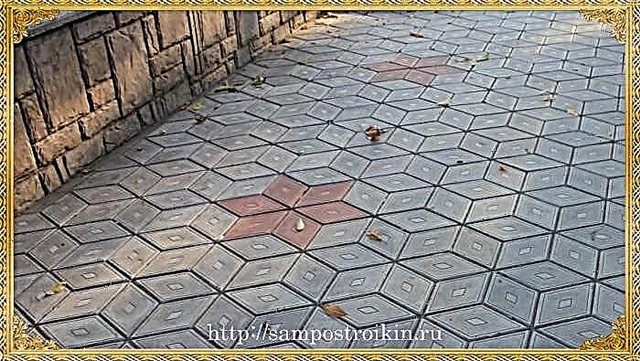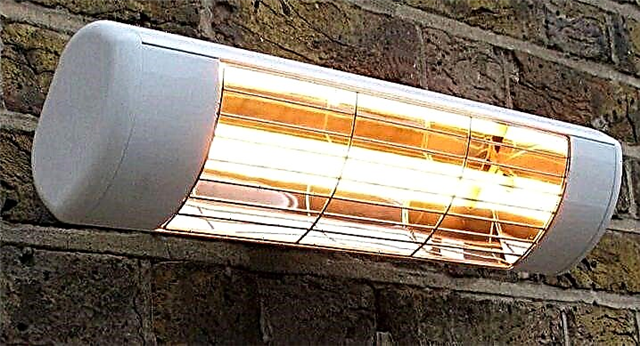
Infrared heater is a relatively young representative of HVAC equipment. This useful device in record time has become popular and in demand. It is actively used for fast local heating of premises for various purposes - apartments, private houses, offices, garages, car washes, construction sites. It is not surprising that IR devices attracted the attention of plant breeders by the possibility of using them to create optimal conditions for the life of green pets grown in greenhouses and greenhouse pavilions.

Features
Our planet has its own heater - the Sun. Thanks to the unhindered passage of thermal energy emitted by it through the air shell of the Earth, its surface is warmed, thereby supporting the life of everything. Infrared heating works on the same principle: by analogy with the sun's rays, infrared devices for greenhouses share their heat directly with surrounding objects. A distinctive feature of infrared heaters is that heat does not enter the air, but onto the ground. This method of heating ensures the optimal distribution of thermal energy in the greenhouse pavilion.
Despite its name, there is nothing complicated in the device of the infrared device. The outer side is equipped with aluminum radiating panels protected by a steel body with a heat-resistant coating. The filling consists of a heating element and a protective ground wire. The principle of operation of infrared equipment is also simple and clear: a heating element transfers heat to plates emitting infrared waves. This energy is then absorbed by the surfaces of surrounding objects and things within the radiation radius of the device.
How it works and what are the benefits
An infrared heater emits electromagnetic waves of different lengths, similar to sunlight, which heat nearby objects and surfaces. The accumulated heat is gradually transferred to the surrounding air.
IR waves are short, medium and long. The higher the temperature of the wave, the less its length and intensity. Accordingly, IR devices differ in:
- Long-wave and medium-wave (they are also called dark), having a relatively low temperature of the radiating element.
- Short-wave (or light), with a surface temperature of over + 800 ° C. They consist of heating elements in the form of a metal mesh or ceramic plate, which emit light visible to the naked eye.
For the installation of such devices, coordination with power supply enterprises is not necessary. Enough power.
Unlike convective systems, infrared heaters do not create air movement, because they evenly heat the soil, plants, walls of the greenhouse, transferring electromagnetic energy to them. In this case, a layer of cold air is not created below.
Currently, there are electric and gas types of infrared heaters. Summer residents have the opportunity to choose modern technologies for heating greenhouses even in the absence of electricity on the site. This alternative allows you to be guided by the principles of economic feasibility.
Gas heater for a greenhouse with infrared burners does not require permits, easy to install and maintain. For its operation, a gas cylinder is required, as well as a smoke exhauster, which discharges gas combustion products to the outside through a chimney.
An infrared heater for the greenhouse, installed near windows or doors, will significantly (up to 40%) reduce heat loss, compensating for them during operation.
Due to the small difference in air and soil temperatures, vegetable crops will create optimally comfortable conditions for ripening. Since the heating of plants occurs due to electromagnetic energy, which is similar to solar, this has a beneficial effect on the growth and quality of the crop.
It has been established that in most cases the palatability of vegetables improves, the content of useful elements and vitamins in the fruits increases, the volume and quality of the crop increase, because ripening is faster.
Long-wave and medium-wave IR emitters do not shine, which allows them to be used in the dark, without creating a daily imbalance to plants.
The infrared heater for the greenhouse due to the economy, environmental friendliness, ease of installation is currently the most optimal way to heat greenhouse farms.
Ways to install IR heaters in a greenhouse
Installation of infrared heaters is quite simple. Their number and location depends on the area of heating, the amount of heat needed, the radiated power.
To ensure uniform local heating of crops during a certain period of their development, electric infrared heaters, as well as their gas counterparts, can be mounted in different places of the greenhouse. Thermal radiation can be oriented to the soil during seed germination, or directly to the plants themselves as they grow.
Most often, infrared ceiling heaters for greenhouses are used. They are installed on special suspensions. A wide-directed flow of electromagnetic energy from several heaters covers almost the entire area of the greenhouse used for planting, creating a slow heat exchange between soil, plants and air.
It should be remembered that infrared heaters must be installedat a height of at least 1 m from soil or plants. Since the approximate distance from the heater to the seedlings should be more or less constant, it is necessary to periodically raise the device as they grow. More precisely, the height can be selected empirically. It is important to note that the higher the heater is installed from the soil surface, the larger the area covered by the device, but the soil temperature is lower.
This principle is convenient when growing vegetable seedlings in a greenhouse in March-April, when seeds are placed everywhere in the soil, an IR heater will create the most optimal conditions for their germination. As the seedlings grow, there is an increase in the outside air temperature, and therefore adult plants require less and less additional heating.
Install infrared heaters in the greenhouse should be at a distance of not more than 1.5-3 m from each other, depending on their power and size, installation height and desired temperature.
Heating a polycarbonate greenhouse with a classic size of 6x3 m will require the installation of only 2 heaters with a capacity of 1.2-1.5 kW, since a standard ceiling IR apparatus of 1.7 m length covers an area of about 3 m².
With a larger width of the greenhouse, it is recommended that infrared heaters be placed not in the center of the ceiling, but on the sides, although this will require not 2, but 4 devices, but of less power, and, accordingly, at a lower price.
Since some models of IR heating systems are quite powerful, there are options for their placement along the perimeter of the greenhouse. This installation method is especially convenient when heating in the cold season or when there is a risk of frost.
Keeping up with the times
Thin infrared films with carbon coating as an emitter of infrared waves are gaining increasing popularity among summer residents. They are placed either on the ceiling or on the walls of the greenhouse.
Some models can even be laid horizontally underground or vertically along the beds. Removable film infrared heaters allow summer residents to choose their own heating system configuration. A standard household IR panel is able to warm soil from 5 to 20 m².
To adjust the temperature for infrared heating, you can additionally purchase a temperature controller or an automatic climate control system, which includes temperature sensors connected to the control controller. This unit is located in any convenient place both in the greenhouse and outside it.
The advent of infrared heating expands the possibilities of greenhouse year-round vegetable growing. At the same time, all the costs incurred will be more than paid for by the quantity and quality of ecologically clean vegetables grown personally.
Support our channel - subscribe, like and leave your comment on this article. We will be very grateful for your support!
Biofuel heating
This method of heating is very old and easy to implement. Biological materials - manure, straw, rags, foliage are recognized not only as good fertilizer, but also perfectly heat the soil, practically without wasting your energy resources. Ideal for this method to use horse, pork or cow dung. Already heated manure or other biofuel is placed in a greenhouse or greenhouse. The upper soil layer is removed on the beds, biofuel is laid there, heaped up with earth. To start rotting again, pour hot water or slurry.
The disadvantages of such heating are that every year you need to change last year's manure for a new one. In addition, you can use the greenhouse when there is no more deep frost or use additional heating. This method is well suited for growing seedlings in greenhouses. It should be noted that according to the experience of gardeners, pig manure can hold a temperature of +14 +16 degrees, horse +33 +38 degrees for up to 90 days, cow manure is able to maintain a temperature of +12 to 20 degrees. Sawdust emits heat up to +20.

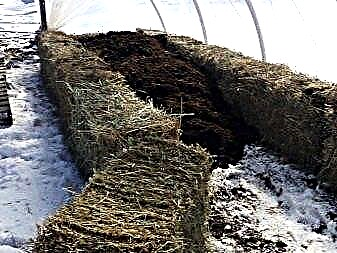
Solar heating
The case when the method is enthusiastically accepted by all summer residents, since it does not require any costs. The main task is to make maximum use of the sun's rays. To do this, you just need to install a greenhouse in a place where solar energy will affect its entire surface.
Such a natural way of heating is good for polycarbonate and glass greenhouses, the shape and design feature are also important. As long as there is solar activity, the greenhouse will regularly warm up.
The disadvantage is the inconstancy of solar energy and a rather short daylight hours, as well as the inability to warm the greenhouse in winter or in cool weather.

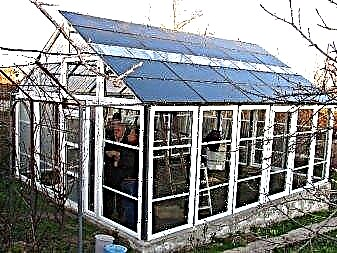
Is it beneficial to install IR in a greenhouse
A heating device for greenhouses has its advantages and disadvantages. Electrical devices are easy to use and allow the complete automation of the heating process. But there are drawbacks, among which we can single out the fact that electricity remains the most expensive energy carrier. IR devices for heating greenhouses consume a lot of energy and work smoothly.
After turning off the device, the temperature drops sharply. To maintain the desired temperature conditions, the device must be constantly functioning. Gas emitters are economical and practical. One of the main advantages of using gas is that IR devices do not dry out the air and positively affect plants. Infrared emitters are ideal for heating greenhouses. For industrial purposes, IR heating has long been used as the most economical and practical option for beneficial effects on plants.

The device must be purchased in packaging, no damage should be. If possible, then check and turn it on in the presence of the seller. Doubts should be caused by the heater, which makes loud noises at the time of operation. Once you have bought the device, do not run home until you receive the documents in your hands: a check and a warranty card with the company's seal.
It must mark the model and brand of the heater. Always choose proven devices, giving preference to popular brands, and create favorable conditions for your plants to grow, and then they will delight you with a variety of crops.
Pros of heating a garage with an infrared heater
Different views for the greenhouse
Equipment of this class is available in various modifications. Among them there are both ceiling and mounted directly in the ground. The first set at a height of not less than 1 m from the surface. They are considered the most popular infrared heater for heating greenhouses, since by heating surfaces, including soil, they create a greenhouse effect.
 Infrared films are located directly on the soil. They can be located around the perimeter of the greenhouse, between the beds and at a depth of 50 cm under vegetable crops. Most often, such devices are used in stationary greenhouses, where the soil does not dig.
Infrared films are located directly on the soil. They can be located around the perimeter of the greenhouse, between the beds and at a depth of 50 cm under vegetable crops. Most often, such devices are used in stationary greenhouses, where the soil does not dig.
There is a separation of infrared heaters and the wavelength.
Depending on this parameter, they are:
- Nearest, closest to the visible light,
- Medium
- Distant.
Often they are called light or warm in everyday life. But to avoid confusion, you should know that the whole difference is in the wavelength. So long-wave or dark have a low temperature of the radiating element, and short-wave or light - over 800 ° C.
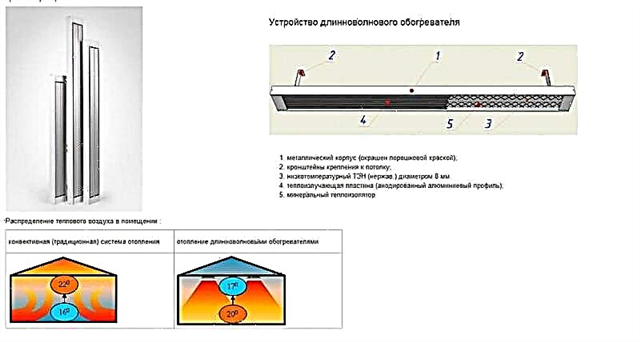 In addition, there is a separation depending on the installation method on:
In addition, there is a separation depending on the installation method on:
The former resemble the shape of an LED lamp and the place for their installation is selected at the design stage of the greenhouse. The portable ones are compact, mobile and equipped with a fan for the rapid distribution of heat.
The power source for such equipment may be an electrical network or a compressed gas cylinder.
Is it possible to use IR heaters in a greenhouse?
Gas or electric heating for greenhouses is considered an ideal solution to the issue of heating. When choosing a heating system, the owner of the greenhouse needs to remember the need to create the following conditions:
- the most uniform heat distribution,
- lack of drafts
- profitability
- practicality.
Another requirement for infrared heating is safety and an automated heating process in accordance with external factors.
Maximum even heat distribution
The method of operation of the heater lies in the ability of infrared rays to affect the surface of objects. The range of heating power is almost not affected by the distance from the source of study, air exchange and the presence of heat loss. If you correctly calculate the power and distribute the emitters, you can get an even warming up of the earth and accelerated plant growth.
Lack of drafts
One of the main reasons for the appearance of drafts is considered to be an incorrectly calculated heating system. When heating large areas, often forced air circulation is created. Warm air flows up, while cold air flows down. In a greenhouse, it is extremely difficult to get places with low thermal insulation. Windows and doors let cold air flow through, so drafts are obtained, to which the flora was sensitive.
Infrared heating of the polycarbonate greenhouse allows you to solve this problem if you install radiators in front of the door or window. Thus, a thermal barrier is created and heat losses are compensated, avoiding the occurrence of drafts.
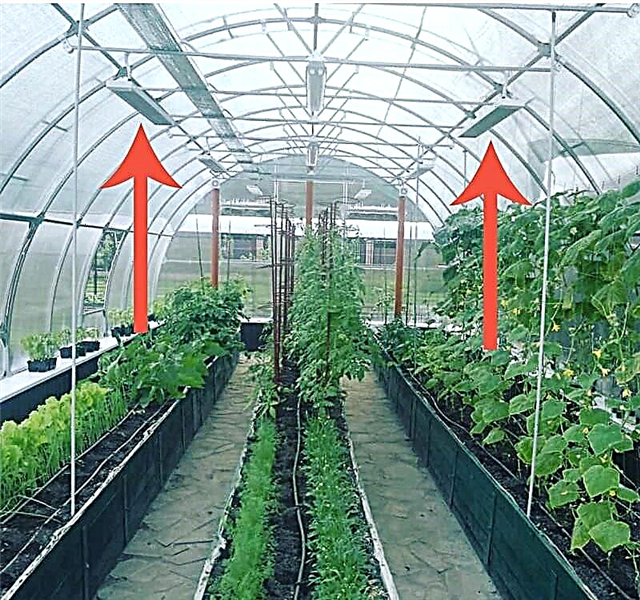
Profitability, convenience and safety
Heating emitters of greenhouses made of polycarbonate or glass does not require large expenditures.Installation can be done by yourself. If you use a thermostat, it will reduce the cost of electricity or gas by 40%. Today, heating a greenhouse with an infrared heater is considered one of the most rationally beneficial solutions. Devices have several levels of protection. Electric heaters have a waterproof housing, which completely eliminates electric shock.
What is called an infrared heater
IR heaters are called special units, which by the principle of their work resemble the sun. The device operates as follows: it produces rays absorbed by surrounding objects and surfaces. And they already give off heat to the air. About the same thermal effect produces the sun. This feature gives infrared heaters for greenhouses a number of advantages.
Types of infrared heaters
There are two varieties of infrared heaters. This is about:
- ceiling plates. They are used to heat greenhouses, the length of which is approximately 4 meters. The plates are placed in one row, but at the same time make sure that at least 1 meter remains to the surface of the beds,
- films laid in the ground. They are installed both vertically and horizontally. And if in the first version the infrared heater is mounted between the beds or around the perimeter of the greenhouse, then in the second it is installed in the soil under vegetables at a depth of 50 centimeters. It is best to use such a heater in stationary hotbeds when they do not need to be constantly dug up and then buryed.
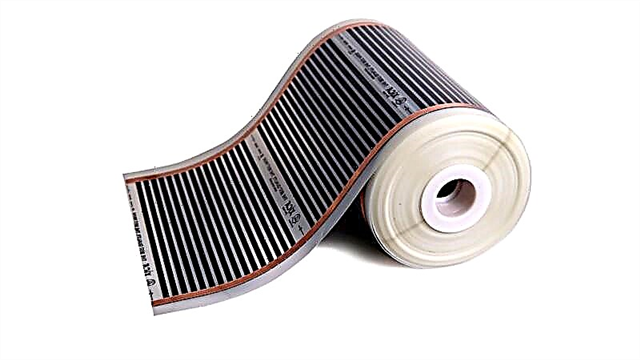

What infrared heaters consist of
The design of IR heaters is extremely simple. They consist of metal bodies coated with heat-resistant enamel, heating elements, which are made of stainless steel tubular electric heaters, aluminum anodized profiles. Foil shields and special heat insulators are installed between the heat-emitting plates and the cases. Removable covers in the structure close the connecting tubes for connecting to power.
Operating principle
The basis of the functioning of this device is the conversion of electricity into thermal infrared radiation, which passes from the plates to the floor and the objects lying on it. They, in turn, give warmth to the environment. The size of the surface heating temperature of the plates is 250 degrees Celsius.
Thus, the infrared component does not reduce the amount of energy, but this keeps constant moisture in the air. With proper calculation, this system saves more than 40% of electrical energy. However, it is worthwhile to understand that for each room the heating system is calculated separately.
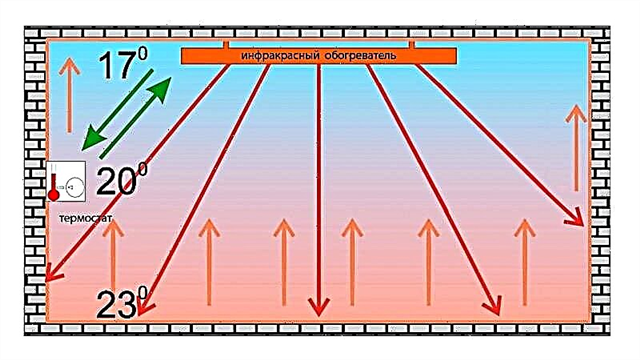
Using more powerful devices
One way to use infrared heating is to use devices with a power of 500 watts. In this case, the distance from the unit to the plants should be at least one meter. Install them either near windows or against walls. Use heaters equipped with a special ceiling mount and hang them, for example, over the subject where the seedlings are. But to say at what height it is necessary to mount the unit is not so simple. The summer resident will need to find out with his own hand. By exposing the IR heater to a certain distance, it cannot be moved until the plants begin to develop. As soon as you notice that they are rising slightly, hang the unit a little higher.
For every two or three meters, one device is mounted. The exact distance between the units depends on the height and scale of the greenhouse. The higher the heater is mounted, the larger the area that it covers. Therefore, hang to the highest possible height (this will reduce the cost of buying appliances). However, keep in mind that altitude affects the abundance of heat given to the plant.

Using less powerful devices
The second option is to use devices with a power of 250 watts. Based on elementary logic, we can conclude that you will have to use more infrared heaters in order to achieve a significant effect. Therefore, in this case, the distance between the units should be no more than one and a half meters. The placement height above the seedlings will also need to be established by experiment.
By analogy with the previous case, wait until the plants begin to grow, leaving the heaters in a static state. Noticing the growth of seedlings, gradually pick them up. The advantage of such an infrared heater is its small size and weight, so hang it with a conventional wire.
There are several secrets thanks to which the summer resident will be able to use infrared heating with maximum efficiency. For example, you can increase the efficiency of the device and at the same time save energy by arranging the devices in a checkerboard pattern. In this case, there will be practically no "dead zones" on the site. True, this recommendation is only suitable if it is necessary to evenly heat the entire area of the greenhouse. If heat is needed exclusively in certain areas, place the units directly above them.
As you can see, infrared heaters are a great way to provide your greenhouse with high productivity through artificial heating. When choosing this device, consider what type you need, and carefully study the characteristics.
Which IR heaters are best used in greenhouses
When using an infrared heating device, please note that they are installed in rooms with no people. IR devices should create conditions for the rapid growth of plants. To simplify the choice of a heating system, the classification of equipment will help:
- by type of purpose, household and industrial devices are distinguished. The former are used for small heated areas. The second is often used in country greenhouses. They function on the short-wave spectrum, which accelerates plant growth. Short waves adversely affect a person,
- by type of fuel used. If you are professionally engaged in the cultivation of vegetables and plants, then it is irrational to use electric emitters due to the high cost of electricity. Large rooms are cheaper to heat with a gas infrared installation,
- light and dark heaters. The use of gas infrared ceiling heaters for heating greenhouses or hotbeds showed in winter that it is rational to install lightening emitters as the main source of heating for large rooms. Dark emitters can uninterruptedly heat a small winter greenhouse,
- type of fixture. Infrared heaters, which are used for heating industrial greenhouses, are installed in the form of ceiling panels. Household models are mounted on a special tripod or fixed to the wall,
- power. Before buying equipment, you need to calculate the right amount of IR heaters in the greenhouse. One industrial device heats a room for 80-100 cubic meters. The household model for heating the earth has a small capacity, sufficient to heat 5-20 square meters.
On the market of climate systems, you can find a wide selection of heaters of Russian and foreign production, which are of high quality and reliability. For industrial use, inexpensive emitter models made in China are not suitable.
The principle of operation of the infrared heater
Infrared heaters differ in principle from other devices, they do not heat the air, but the surrounding objects, that is, they act on the principle of sunlight.

Scheme of heat distribution in the greenhouse.
When taking pictures with thermal cameras of the situation in the room using infrared devices, one can observe the following picture: the maximum temperature is observed near the equipment and at the floor surface, that is, heating is felt immediately after switching on. And with a conventional heater, warm air rises up, that is, it takes a very long time to wait for the temperature to rise below, and this significantly increases the energy consumption. That is, we can conclude that infrared heaters are much more economical, it is recommended to choose them when the consumption of electricity is a critical value, comfort is a priority.
Tube and film heaters with minimal energy consumption
To install an effective and simple IR heater, ceiling lamp and film structures are often used, which are very easy to install, their energy consumption is quite economical.
The scheme of the device of the infrared lamp heater for greenhouses.
Tube infrared devices use halogen lamps with a tungsten filament in a bulb filled with a mixture of argon and nitrogen as a radiation source. The power of such lamps is 150-250 W, which is quite enough to heat an ordinary living room. Lamps for such devices are available in various:
- ordinary infrared SLRs, which are similar to ordinary lamps for lighting, but emit more infrared rays,
- mirror red infrared lamps with a bulb of dark red glass, they give little light, but more heat, and the energy consumption is much less.
Film infrared heaters are attractive in that they do not have a housing, that is, they are a film with carbon paste with a thickness of one micron. Such a film has failed copper contacts. You can choose such a heater if you need to heat the device to a maximum of 110 degrees, and the average heating temperature is 30-45 degrees heat. The energy consumption of the film heater is not very large, it is often used for installation not only on ceilings, but also for underfloor heating.
Gas panels and long-wave infrared
Gas infrared heaters are mainly used for local heating of small areas on the street. This allows you to create comfortable conditions on the verandas, in outdoor cafes, terraces. Often, gas appliances are made in the form of elegant modern lanterns that serve as a decoration for the design.
Types of infrared radiation.
The device itself is a gas cylinder, hidden under the base of the umbrella. The cylinder consumption is very economical, it lasts for 22-25 hours of continuous operation, so they are often taken for picnics, put on playgrounds, sports grounds, in parks. There is enough power in order to feel comfortable even at subzero temperatures.
Gas ceiling heaters are used when a mobile heat source is needed on the territory from 9 to 60 sq. M, the balloon is liquefied gas.
Most often, long-wave devices are used for heating a house, the source of radiation in which is a special plate of aluminum alloy with a special coating. Such a plate is heated by heating elements up to 300 degrees Celsius, between it and the case there is a heat-insulating material that provides heating of the case itself to only 50 degrees, that is, the heat is sent exactly where it is needed.
Household infrared devices of this type are available in the form of rectangular cases, they are mounted on the ceiling with special brackets, the angle of the device can be easily adjusted. Long-wave devices are very convenient for heating not only in residential premises, they can also be successfully used for offices, shops, kindergartens.
Varieties of heating systems for a polycarbonate greenhouse
The simplest solution to the issue associated with the organization of additional heating in the greenhouse can be the installation of a conventional furnace in the room. In this case, the stove is erected in the middle of the room, the chimney is brought out, firewood, coal, and peat are used as fuel. In order for the plants to feel comfortable, equip a simple ventilation system. It would seem that this method is quite simple and affordable to implement, however, the most basic drawback of furnace heating is that it is impossible to achieve uniform heat distribution over the entire area of the greenhouse. Therefore, plants closer to the furnace receive an excess of heat, and their farther counterparts - a disadvantage.
Some summer residents try to equip electric heating in the greenhouse. To do this, they mount various tena, convectors, fan heaters along the perimeter of the greenhouse. Also, cable heating systems for greenhouses are very popular, which ensure uniform distribution of heat throughout the room, while installation and subsequent maintenance require a minimum investment of money. Electric heating systems of the greenhouse can be connected to an automatic controller that will adequately respond to changes in air temperature outside the room, maintaining a predetermined temperature in the greenhouse. Those wishing to equip electric heating in their greenhouse should not forget that they have to pay for electricity. The cost of paying for electricity for heating the air in the greenhouse directly depends on the type of heating element selected, so electric heating is not always justified from an economic point of view.
The most acceptable way to heat a greenhouse is to use infrared heaters. Infrared heaters do not heat the air in the room, they only heat the plants. Moreover, infrared heaters do not emit light, consume a small amount of electrical energy, which justifies their use even in small greenhouses.
Installation of ceiling heaters
The small infrared ceiling heater for domestic use can be easily installed with your own hands. This can be done by a professional electrician or an ordinary person, the main thing is to follow all stages exactly. It is necessary to start with the correct placement of equipment, it is impossible to install the device less than 30 cm to furnishings and room structures. Now we need to decide what is included in the kit of a conventional ceiling heater:
- the infrared device itself (it can be any design, including glass panels),
- device suspension elements,
- heating electric heater,
- heat emitting plate
- fasteners, clamping plate,
- screws, bolts and more.
The scheme of the device of the IR lamp for the greenhouse.
Often, all the necessary fasteners are already complete with heaters for installation on the ceilings, these can be cables, chains, etc. In this case, it turns out to ideally determine the height of the heater, if necessary, adjust it.
Installation steps include:
- First you need to select the installation location, mark it with a simple pencil,
- then the infrared heater is pulled out of the package, located on a horizontal flat surface with the plate down,
- a screw-ring is screwed on the ceiling, chain links for fasteners are suspended, their reliability is checked,
- the heater is suspended on a chain to a selected height between the brackets (all the screws must enter the prepared grooves, after which they are tightly wrapped),
- the heat-emitting plate is rubbed with alcohol before the connection,
- the ends of the cable are connected to the heater and the fixed network in strict accordance with the scheme provided by the manufacturer,
- a device with a temperature regulator should be located approximately 1.5 m from the floor level, the device itself should not be in the field of action of the heater's rays, in a draft or near other heat sources.
There are other mounting options, for example, using terminals for glass heaters. These household appliances are a tempered glass decorative panel that is attached to the ceiling using a terminal block and self-tapping screws
There are gas heaters, the installation principle of which is also different, so when buying, always pay attention to how the device will be mounted, do you have conditions for its installation
Infrared heaters today are used not only for heating a private house, but also for shops, cafes, industrial shops, even for open spaces. Not all heating appliances are capable of this. At the moment, this is the most promising type of heaters with a wide variety of advantages.
During installation, you can observe the smallest length from the device itself to structures and furnishings, that is, infrared heaters are absolutely safe. Manufacturers today offer us various models, including gas appliances for ceiling mounting, industrial and domestic, outdoor. The devices themselves can be made of special film, glass, and have various heating elements. Installing household IR devices is also very simple, usually mounting ceiling mounts is enough, the device itself is fixed using special brackets, terminal blocks or suspended on chains and cables.
Rules for heating greenhouses with infrared devices
Such equipment is very easy to install and connect, so this work can be done independently. But it is necessary to follow the recommendations of specialists. For example, installing heaters at windows and doors can reduce heat loss. When organizing heating, you need to focus on the power of the devices.
Convenient to use devices with special mountings to the ceiling. Such heaters can, for example, be hung above the table where the seedlings are located. But to say at what height the device should be located is difficult - this will have to be determined first hand. By installing the heater at a certain height, it cannot be moved until plant growth begins. When crops rise, an infrared heater for the greenhouse will need to be hung higher. If it is not possible to attach the device to the ceiling, you can fix it on a rigid basis.

As for the number of heaters, then for every 1.5-3 meters of area there should be one device. The distance between them depends on the size of the greenhouse and the height at which the devices are located. The higher the device is located, the larger the area it heats. Therefore, if possible, heaters should be installed higher, then less of them will be required. However, one must not forget that the higher the device is, the less heat the plants receive. Nevertheless, it is better not to save, but to proceed from how much more comfortable the crops will be.
You can also use devices with a power of 250 watts. In this case, more instruments will be required to achieve the optimum temperature. The distance between them should be 1.5 meters. The height of their placement above the plants will also need to be determined on their own experience. The position of the heaters should remain the same until the seedlings begin to grow. Gradually, as the plants grow, the instruments are raised to a great height. Heaters of such power are small in size and weight, they are simply suspended on wires. The height of the devices is very easy to adjust - just pull or release the wire.
There are some recommendations that will make infrared heating for greenhouses as efficient and economical as possible. For example, they can be staggered - then the room will be evenly heated throughout the area, and energy consumption will become less. In this case, the number of unheated plots will become minimal. However, such advice can be used only if you need to evenly heat the entire greenhouse. If you need to create different temperatures in different parts of the room, you should not follow this recommendation. In this case, you need to install heaters in those places where you want to achieve a higher temperature regime.
Heating the greenhouse with an infrared heater, see the video:
The advantages of infrared heaters
An infrared heater is equipment that emits rays similar to the sun. Objects and surfaces absorb them, and they, in turn, give off heat to the air. Exactly the same thermal effect gives sunlight.
Due to this, infrared heaters have the following advantages:
- low power at high efficiency, which saves on electricity,
- practicality in operation,
- do not create drafts,
- evenly distribute heat throughout the room.
Using convective heaters, you can notice that the heated air rises, and the cold remains below. Such devices are ineffective in terms of heating greenhouses, since the plants are just below, and they will not be enough heat. Infrared heaters for greenhouses are good just in that they evenly distribute heated air, thereby creating optimal conditions for plant growth.

Also, IR devices are able to get rid of drafts, which are undesirable for many vegetable crops and greens. To do this, you just need to place the device in the area where there is poor thermal insulation - during operation, it will eliminate heat loss without creating air movement. Infrared batteries have high efficiency.
These devices are highly practical. Their advantage over other heating devices is the ability to divide the room into zones, setting in each a special temperature regime. With high efficiency, infrared heaters are economical: if they are installed and used correctly, energy consumption can be reduced by 40%.
These devices allow you to warm the soil to a depth of 5-7 centimeters, and this stimulates the root system of plants, creates the necessary conditions for successful development. Other heating devices cannot purposefully heat the soil. IR rays warm the earth to 28 degrees - the optimum temperature for plant growth. Moreover, in the room itself, the air temperature is about 21 degrees.
Also, infrared devices are safe to use, so they can be left turned on unattended by setting the desired temperature level.
How to do infrared heating in a polycarbonate-based greenhouse with your own hands
In order to equip a polycarbonate greenhouse, located on a summer cottage or a suburban area, with infrared heaters, it is not at all necessary to attract expensive specialists. All work can be done independently. The only condition: if you do not have the skills to work with electrical equipment, do not know the basics of electrical safety, it is better to involve a professional in the work related to connecting infrared radiation sources to the network.
- 2-4 ceiling heaters should be installed in the upper part,
- in the lower part, for effective soil heating, it is necessary to install film-type heaters.
In order to achieve maximum effect from the operation of ceiling heaters, in the middle of the structure, under the location of the infrared devices, a concrete path should be equipped. It will accumulate the heat generated at the top and evenly distribute it throughout the room. The film heaters buried in the ground will warm the soil from below.
To install film heaters, it is necessary to remove the topsoil to a depth of 40-50 cm. At the bottom of the resulting trench, sand should be poured with an even layer. Further, any heat-insulating material having an insignificant coefficient of moisture absorption is laid on a sand pillow. Foamed polystyrene can be used for this purpose. The purpose of this insulating layer is to retain heat and prevent its penetration into the soil. Further, after the polycarbonate or other similar insulation is laid, it must be covered with another layer of sand 5 cm thick. The sand needs to be poured with water, and then carefully packed.
Then, a film infrared heater is placed on a layer of compacted sand. Before laying the heater, do not forget to connect the power wires to it and bring them out of the trench. After laying the film infrared heater, its surface is covered with another layer of sand, which is watered and tamped to remove air bubbles. If air bubbles are not removed, they will act as unwanted resistance in the heat path. Then, a perforated sheet of asbestos cement or a metal mesh is placed on the sand layer, which will protect the heating element from possible mechanical damage that may occur during digging of the soil inside the greenhouse. Further, the remaining space of the trench is filled with ordinary fertile soil.
How to choose an IR heater for a greenhouse
Of course, it should be borne in mind that positive feedback from infrared heaters was received from people who were able to choose the right device for their greenhouse and install it properly. The most positive effect from the operation of the device depends on the exact calculation of heating systems, connections and location.
So, to explain everything simply and quickly, we consider the calculation using an example of a standard greenhouse with dimensions of 6x3 m. For such an area, only two heaters with a capacity of 1.2 kW to 1.5 kW are enough
But it is important to consider not only the power, but also the size of the devices themselves. For example, a device with a length of about 1.8 m with a beam scattering angle of 100-120 degrees is able to heat a zone measuring 2.5x3 m
Even the most crude calculations will make it clear that two heaters for the greenhouse taken as an example are more than enough. Of course, for larger areas you will need more heaters or more powerful models.
For wide greenhouses there is another option - to install heaters not in the center, but on both sides. To do this, you will need about 4 devices, and their power should be reduced by 2 times, respectively. So you can be absolutely sure that every square centimeter of space falls under the warm influence of the rays.
Types of heaters
There are several types of IR for greenhouses. Varieties were described above in terms of the nature and length of the radiation, but now the difference lies in the installation method.
Types of devices by installation type:
- Ceiling - the optimal location a meter from the surface of the earth. Best suited for greenhouses with high levels of humidity, creating an additional greenhouse effect,
- soil - are placed directly on the ground,
- wall mounted
- infrared films - can be installed on the ground vertically or horizontally. Vertical installation is carried out between the beds when the film goes around the entire perimeter. With horizontal installation, the film is dug into the ground to a depth of about 50 cm under the beds. This method is more suitable for a stationary greenhouse, when you do not need to regularly dig the beds.
General information
When growing garden crops in a greenhouse, special attention must be paid to the microclimate. Regardless of the time of year and the ambient temperature inside the building, comfortable conditions must be present under which the growth, development and yield of plants will be the most productive
And no matter what type of heaters will be used, it should perform its basic functions in the best possible way.
 Infrared heaters simulate sunlight
Infrared heaters simulate sunlight
Some gardeners equip heating systems with their own hands, constructing small stoves with solid fuel. However, such inventions are not famous for safety and need constant monitoring and adding fuel. In addition, they only heat the air, which is why efficiency indicators are seriously reduced. Often pipes with water, which are located along the perimeter of the greenhouse, are brought to the structures. Unfortunately, this approach does not improve heating productivity, but only requires large investments.
The next type is electric air heaters. They are easy to install and also support full automation, which makes them comfortable to use. Unlike the previous type, such systems do not heat the air, but also do not boast of a high level of efficiency.
Among the advantages of electric fan heaters, there is instant heating of the internal space, although this leads to one unpleasant phenomenon - excessive air drying. In turn, overdried air negatively affects green spaces and reduces yield indicators.

The most inappropriate heater option is a gas appliance. During the operation of such a system, any air humidity drops to minimum values, which entails fatal consequences for the crops grown.
Also, when arranging electric heaters for greenhouses, heating soil cables are considered. They are able to warm up the root system of plants, but are not cheap and need expensive maintenance.
In this video you will learn more about infrared heaters,
Ways to increase the efficiency of the heating system
As you know, infrared heaters do not heat the air, but objects, including the ground of the greenhouse. At the same time, they are able to warm the soil only by 7-10 cm, and as plants such as cucumbers grow, the soil gets less heat. Therefore, to increase the efficiency of the heating system, experienced vegetable growers recommend providing for soil heating. The following options are possible:
- supply of warm air from any source through pipes,
- traditional cable "warm floor"
- laying a layer of foam between the foundation and the ground,
- laying under the ground IR film PLEN.

Penotherm - an effective and inexpensive material for thermal insulation of greenhouse soil
Penotherm is widely used as a heater for saunas and baths. He is the most budgetary way of thermal insulation of the soil of the greenhouse. We use material with a thickness of 0.5 cm, which is laid directly on concrete with an inlet on the walls of the greenhouse to a height of 10-15 cm. A layer of soil up to 50 cm thick is poured on top of the insulation. Such a “pie” tolerates frosts of 30-40 ° C.
An infrared film can be laid under the ground to a depth of 30-50 cm in stationary greenhouses or used for temporary heating, covering plants from above only on very cold days. The film under the ground can be mounted both horizontally on a foundation of concrete or gravel, and vertically around the perimeter or between the beds. Convenient film heaters also when growing seedlings in drawers on shelves or on the floor.

An infrared film can be used for “lower” heating of the soil of a greenhouse, or it can cover plants from above in very cold periods
When placing IR units in a greenhouse, it is also useful to consider the recommendations of experienced users.
The potential of infrared heating appliances with a capacity of 500 watts is fully manifested when they are placed in the coldest zones of the greenhouse along walls and windows.Moreover, the distance from the device to the plant should not be less than 1 meter. Powerful heaters with ceiling mounts are effective. They are placed over tables with seedlings, over tall plants in the ground, but the optimal height of placement in each case must be determined empirically independently.
Usually, for each 1.5-3 meter length of the greenhouse, 1 heater is mounted. The higher the ceiling of the greenhouse, the larger the area covered by one appliance. True, the higher the unit is located, the less heat the plants receive.
To some growers, the infrared heating scheme of a greenhouse with 10-12 heaters with a power of 250 W seems more flexible. It allows you to concentrate more devices in one zone, leaving the other cooler. In this case, the distance between the heaters should not exceed 1.5 meters, and the height of their placement above the plants is also determined empirically: first lower lower, and as they grow.
To increase the efficiency of the infrared heating system and at the same time reduce energy consumption, the heaters are staggered over the plants, thereby reducing the number of "dead" zones.
An example of the organization of infrared heating of a greenhouse based on 3 units with a power of 1000 W per video:
Users note the only drawback of infrared heating in greenhouses is the cost. But plants with fast growth and high yields fully offset these costs.
Variety of IR heaters
Today you can choose a variety of infrared heaters, which are divided into:
- Low-temperature ceiling infrared (long-wave) models. The heating of such devices ranges from 100 to 600 degrees, they are used for residential premises, where the ceiling height is not more than 3 m. The energy consumption of such devices is very economical, and the atmosphere in the room is comfortable and pleasant. Air does not dry out when used.
- It is better to choose medium temperature infrared (medium wave) when it is necessary to heat a room with a ceiling height of 3 to 6 m. The heating temperature is from 600 to 1000 degrees, this equipment is great for large residential and non-residential premises, restaurants, cafes.
- High temperature infrared (shortwave). Such devices are heated to a temperature of 1000 degrees, they are used for installation in production shops, warehouses, in stores where the ceiling height is from 6 to 8 m.
Stove heating
To heat a greenhouse using stoves, boilers or fireplaces is one of the easiest and most economical ways. A brick or metal stove is installed in a greenhouse, the air is heated by heat from the stove and smoke. The pipe runs along the perimeter and out.
From burnt firewood remains ash, which is great for fertilizing the soil.
The downside is that the heating occurs unevenly, so the soil must be heated additionally with the help of manure, electric or water heating.

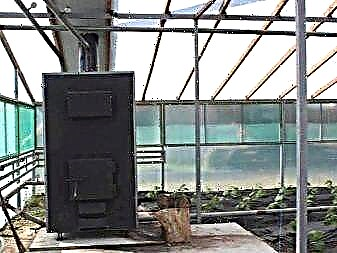
Gas heating
A method where heating is carried out by means of a burning gas will not require large expenditures. In a small greenhouse, it is much more convenient to do without connecting a gas supply by using conventional gas cylinders. Gas burners are distributed over all areas of the greenhouse, heated air rises, cools and falls, creating a comfortable temperature for planted seedlings. Complexity remains in the uniform distribution of heat.
In addition, a ventilation system is definitely needed, since oxygen is burned in the greenhouse. The heated air is well distributed by gas convectors, which are mounted on the wall of the greenhouse and have an insulated closed burner and a tightly closed heat exchanger. They work automatically, heat diverges, while warming the air. Coaxial pipe provides adequate ventilation.
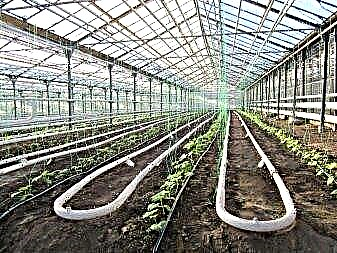

Air heating
The most primitive way of air heating can make even a novice summer resident. Its essence is that warm air from a street fire is fed into the greenhouse through a pipe. The pipe is placed indoors, and one end of it goes out into the street where a fire is made and, getting inside the pipe, heats the air. Electric heating methods are popular among gardeners.
The main plus is temperature control and availability at any time of the year.

Fan heater
Another option for air heating is the installation of a fan. Fan heaters are compact in size, easy to operate and convenient in price. In use, the flow of hot air moves in one direction. Fans can be installed anywhere in the film greenhouse and warm the air in a short time.
The minus of the fan is that it consumes a large amount of electricity.
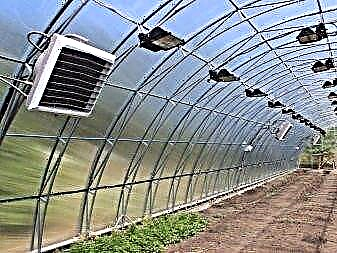
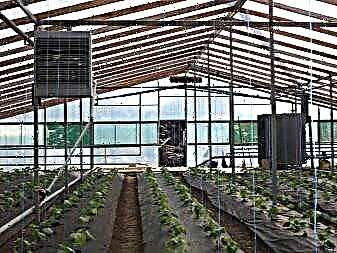
Heat gun
A simple and effective way to heat a greenhouse. The heat gun can be suspended from the ceiling or put on the floor in the room. They are electric, diesel or gas. Due to the powerful fan and heating element, air under pressure is distributed along the perimeter of the greenhouse. Depending on the specifics of the room, you can choose the perfect heat gun for each specific option. For example, there are guns adapted to work in high humidity, dusty air and other difficult conditions.


Heating with heating cable
Many gardeners use a “warm floor” to heat the soil and maintain the desired temperature in the greenhouse. This design is simple and popular. Make it yourself is not difficult. The top layer of soil is removed from the beds, a layer of sand 5-10 cm is poured onto the bottom. Then a heater is laid, experts recommend the use of expanded polystyrene, polyethylene foam or other moisture-resistant materials. From above everything is closed with plastic wrap or any other waterproofing material.
After this, sand is poured, wetted and compacted, the heating cable is laid on compacted sand. All this again fall asleep, lay a mesh netting and the removed topsoil. Due to the fact that the cable is not deep from the soil surface, the soil warms up and the heat remains below. In addition, heat rises into the air, which allows you to maintain a comfortable temperature even in winter. You can control the temperature using the thermostat.
Obvious advantages:
- easy installation
- stable microclimate in the greenhouse,
- plant growth is accelerated due to soil warming at the roots,
- the choice of planted crops is increasing,
- soil heating can be regulated,

Infrared Ceiling Electric Heaters
One of the most modern trends, easy to install and safe to operate. Heaters are made in the form of ordinary bulbs that are attached to the frame of the greenhouse along the entire length of the ceiling. The principle of their work is that they produce rays similar to the sun. They allow you to deeply warm the soil, while not spending a lot of electricity. The location under the ceiling is very convenient, since the heaters do not take up space and do not interfere with the care of plants.
Infrared heaters have several advantages:
- save energy
- do not dry the air, since only objects are heated, which then give off heat to the atmosphere,
- safe, do not emit harmful substances,
- natural way to heat the greenhouse.


When installing infrared heaters, some features must be taken into account. For example, the installation height starts from a meter, and the distance between the heaters is from 1.5 meters. The higher they are from the ground, the infrared ray coverage becomes larger, but the temperature decreases.
There should always be the same distance between the bulb and the plant, so the heater will have to be regulated as the plants grow. The number of bulbs depends on the size of the greenhouse or greenhouse and the required temperature.
Such heaters are a winning purchase, although their cost is much higher than analogues.


Water heating
You can organize the most comfortable temperature in the greenhouse using water heating. It can be made from the stove, if you attach a water boiler to the stove. In this case, hot water circulates continuously and transfers heat through the pipes to the atmosphere.


Heat pump
Equipment that is connected to boilers or other heating appliances. It can turn on automatically, saves energy. An additional plus is that this system can also cool the temperature in the greenhouse during hot weather, which will create excellent conditions for increasing yields. It is considered one of the most popular modern methods of heating.
Benefits:
- allows you to warm a large area,
- can warm water for irrigation,
- does not emit harmful substances
- easily adjustable.

To arrange heating in your own greenhouse is possible for everyone, the main thing is to correctly determine the most suitable heating method for you. It all depends on the requirements and financial costs. There are completely free methods that fully justify the saying "a gimmick on inventions of cunning." For example, in order to warm a small greenhouse per 1 m2 in early spring, when seedlings can freeze, gardeners light thick candles between its rows. For a small greenhouse this will be enough.
To prevent temperature fluctuations in the room at night, a bucket of hot water and several bricks heated on a fire are left in the greenhouse. They will give their heat and heat the room. Of course, the temperature will not rise due to this, but these methods will not allow it to become lower.
Top 4 options for homemade stoves for the greenhouse - in the next video.


